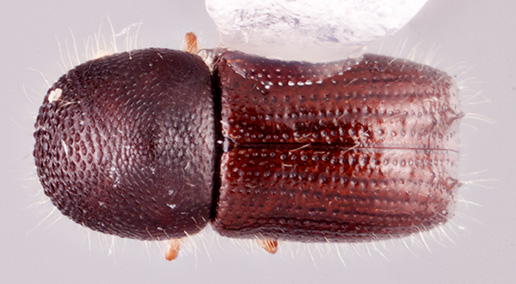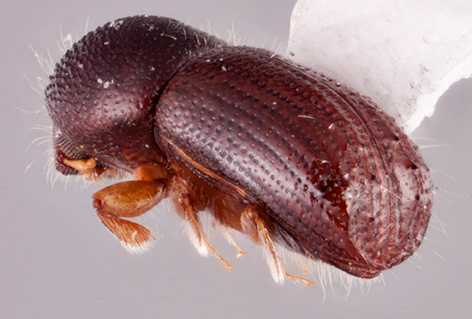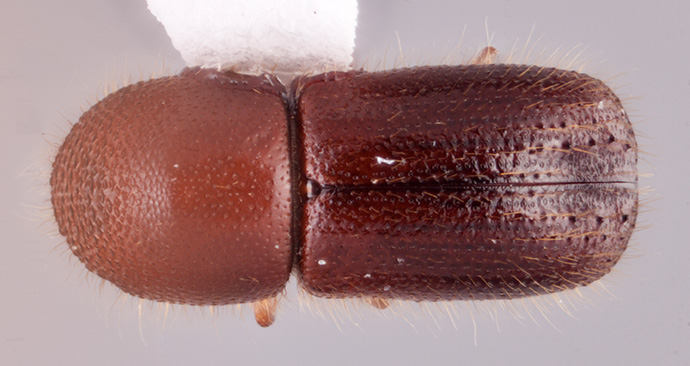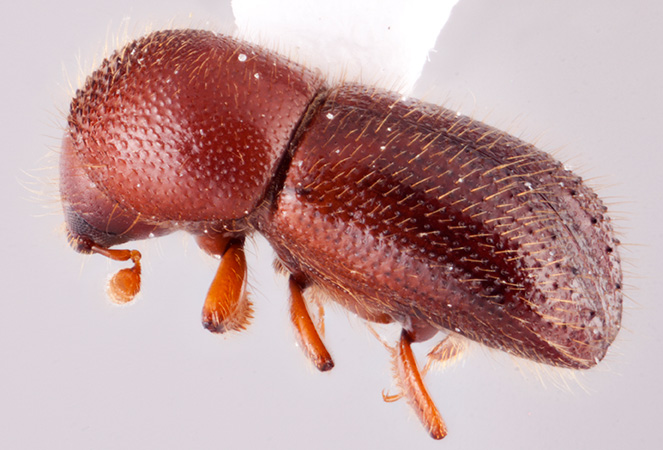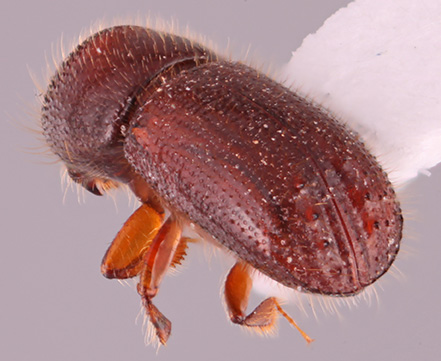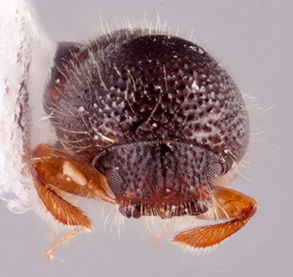Ambrosiophilus osumiensis
|
Ambrosiophilus osumiensis (A. metanepotulus) lateral; R.K. Osborn |
|
Ambrosiophilus osumiensis (A. metanepotulus) dorsal; R.K. Osborn |
|
Ambrosiophilus osumiensis (A. metanepotulus) declivity; R.K. Osborn |
|
Ambrosiophilus osumiensis dorsal; R.K. Osborn |
|
Ambrosiophilus osumiensis declivity; R.K. Osborn |
|
Ambrosiophilus osumiensis (A. nodulosus) dorsal; S.M. Smith |
|
Ambrosiophilus osumiensis (A. nodulosus) declivity; S.M. Smith |
|
Ambrosiophilus osumiensis (A. metanepotulus) frontal; R.K. Osborn |
Taxonomic history
Xyleborus osumiensis Murayama, 1934: 292.
Ambrosiophilus osumiensis (Murayama): Smith et al., 2018b: 393.
Synonyms
Xyleborus metanepotulus Eggers, 1939b: 119. Smith et al., 2018b: 393.
Xyleborus nodulosus Eggers, 1941b: 233. Smith et al. 2020b: 65.
Xyleborus pernodulus Schedl, 1957: 85. Unnecessary replacement name. Browne, 1961c: 50.
Xyleborus hunanensis Browne, 1983b: 33. Beaver 2011: 283.
Ambrosiophilus peregrinus Smith and Cognato, 2015: 216. Smith et al. 2017: 552.
Diagnosis
2.3−3.2 mm long (mean = 2.6 mm; n = 7); 2.3−2.67 times as long as wide. This species can be distinguished by declivitaldeclivital:
pertaining to the elytral declivity
interstriae 1 unarmed, 2 armed by 3−5 pointed tuberclestubercle:
a small knob-like or rounded protuberance of the exoskeleton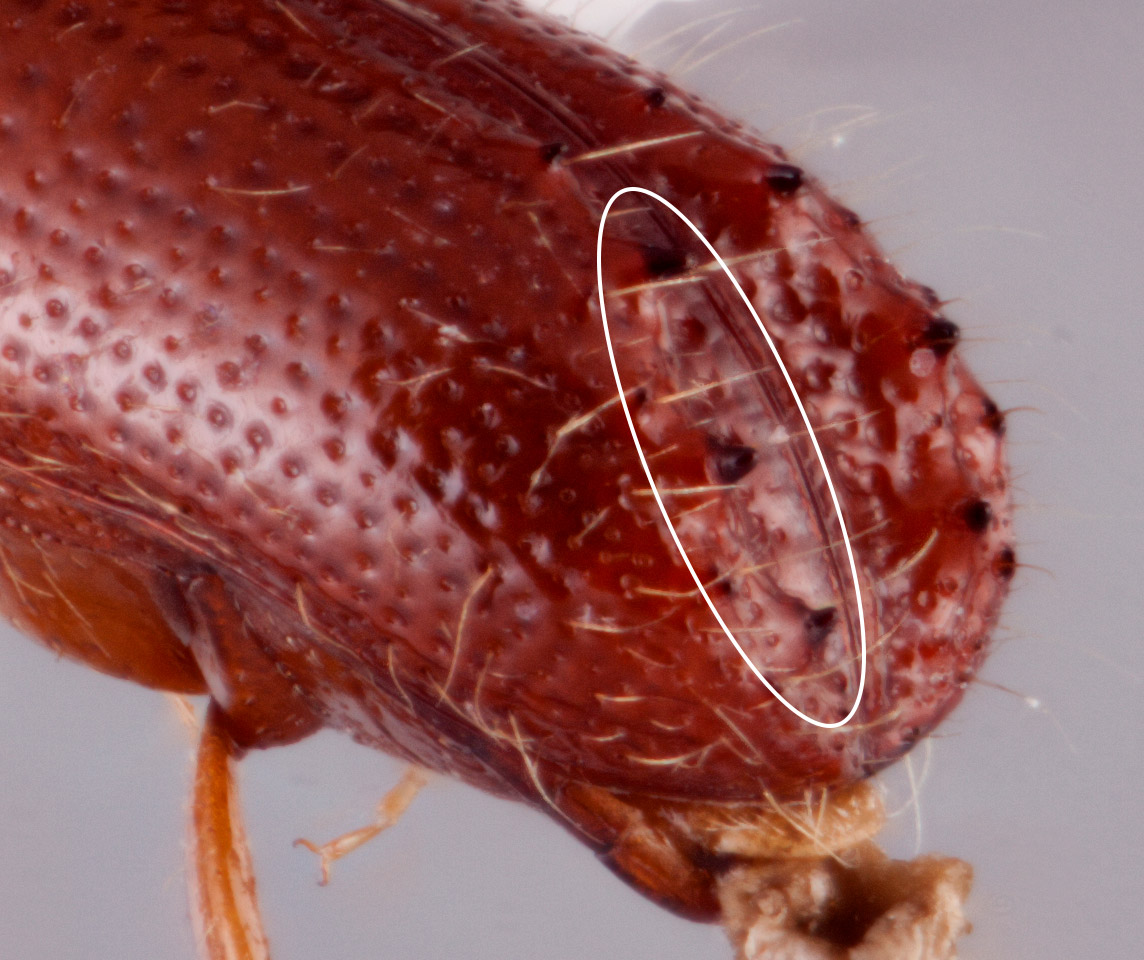 along its length, major declivitaldeclivital:
along its length, major declivitaldeclivital:
pertaining to the elytral declivity
tubercles on interstriaeinterstria:
longitudinal spaces along the elytra between the striae, which is not as<br />
impressed and bear smaller punctures.
 2; weakly to moderately sulcatesulcate:
2; weakly to moderately sulcatesulcate:
deeply furrowed or grooved
to striaestria:
punctures in rows, which may or may not be impressed to make grooves 1, interstriaeinterstria:
1, interstriaeinterstria:
longitudinal spaces along the elytra between the striae, which is not as<br />
impressed and bear smaller punctures.
 2 convexconvex:
2 convexconvex:
appearing rounded , bearing 3−5 pointed tuberclestubercle:
, bearing 3−5 pointed tuberclestubercle:
a small knob-like or rounded protuberance of the exoskeleton and several small granulesgranule:
and several small granulesgranule:
a small rounded protuberance, like grains of sand
 (near apicalapex:
(near apicalapex:
point or edge furthest from the body; opposite of base
 and basalbase:
and basalbase:
point or edge closest to the body; opposite of apex margins) along its length; pronotumpronotum:
margins) along its length; pronotumpronotum:
the dorsal surface of the thorax
from dorsaldorsal:
of or relating to the upper surface; opposite of ventral
 view basic or subquadratesubquadrate:
view basic or subquadratesubquadrate:
almost quadrate, with oblique corners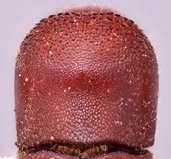 (type 2 or 3); and pronotumpronotum:
(type 2 or 3); and pronotumpronotum:
the dorsal surface of the thorax
from laterallateral:
pertaining to the side
 view basic (type 0).
view basic (type 0).
May be confused with
Ambrosiophilus papilliferus, A. subnepotulus, and A. wantaneeae
Distribution
China (Anhui, Chongqing, Fujian, Guangxi, Guizhou, Hunan, Jiangxi, Sichuan, Yunnan), Myanmar, Japan, Taiwan, Vietnam; imported and established in USA (Smith and Cognato 2015Smith and Cognato 2015:
Smith SM, Cognato AI. 2015. Ambrosiophilus peregrinus n. sp., an exotic ambrosia beetle discovered in Georgia, U.S.A. (Coleoptera: Curculionidae: Scolytinae). The Coleopterists Bulletin 69: 213-220. https://doi.org/10.1649/0010-065X-69.2.213, Schiefer 2018Schiefer 2018:
Schiefer TL. 2018. First record of the introduced ambrosia beetle Ambrosiophilus nodulosus (Eggers) in Mississippi, with notes on the distribution of Ambrosiodmus minor (Stebbing) (Coleoptera: Curculionidae: Scolytinae). The Coleopterists Bulletin 72: 384-385. https://doi.org/10.1649/0010-065X-72.2.384)
Host plants
This species is likely polyphagous and has been recorded from numerous host families including Pistacia (Anacardiaceae), Ilex (Aquifoliaceae), Quercus sp. (Fagaceae), Cinnamomum (Lauraceae), Broussonetia (Moraceace), and Ligustrum (Oleaceae) (Smith et al. 2020bSmith et al. 2020b:
Smith SM, Beaver RA, and Cognato AI. 2020b. A monograph of the Xyleborini (Coleoptera, Curculionidae, Scolytinae) of the Indochinese Peninsula (except Malaysia) and China. ZooKeys 983: 1-442. https://doi.org/10.3897/zookeys.983.52630) and Albizia lebbek (Fabaceae) (Smith et al. in review).
Remarks
The morphology of A. osumiensis is highly variable in regard to numerous characteristics that are routinely used to diagnose other xyleborine species. Such variation includes: the antennalantennal:
pertaining to the antennae
club type either 3 or 4; pronotumpronotum:
the dorsal surface of the thorax
basic (type 2) or subquadratesubquadrate:
almost quadrate, with oblique corners (type 3) from dorsaldorsal:
(type 3) from dorsaldorsal:
of or relating to the upper surface; opposite of ventral
 view; elytralelytral:
view; elytralelytral:
pertaining to the elytra
declivitydeclivity:
downward slope of either the pronotum or elytra
 shining or shagreenedshagreened:
shining or shagreenedshagreened:
covered with a closely-set roughness, like shark skin 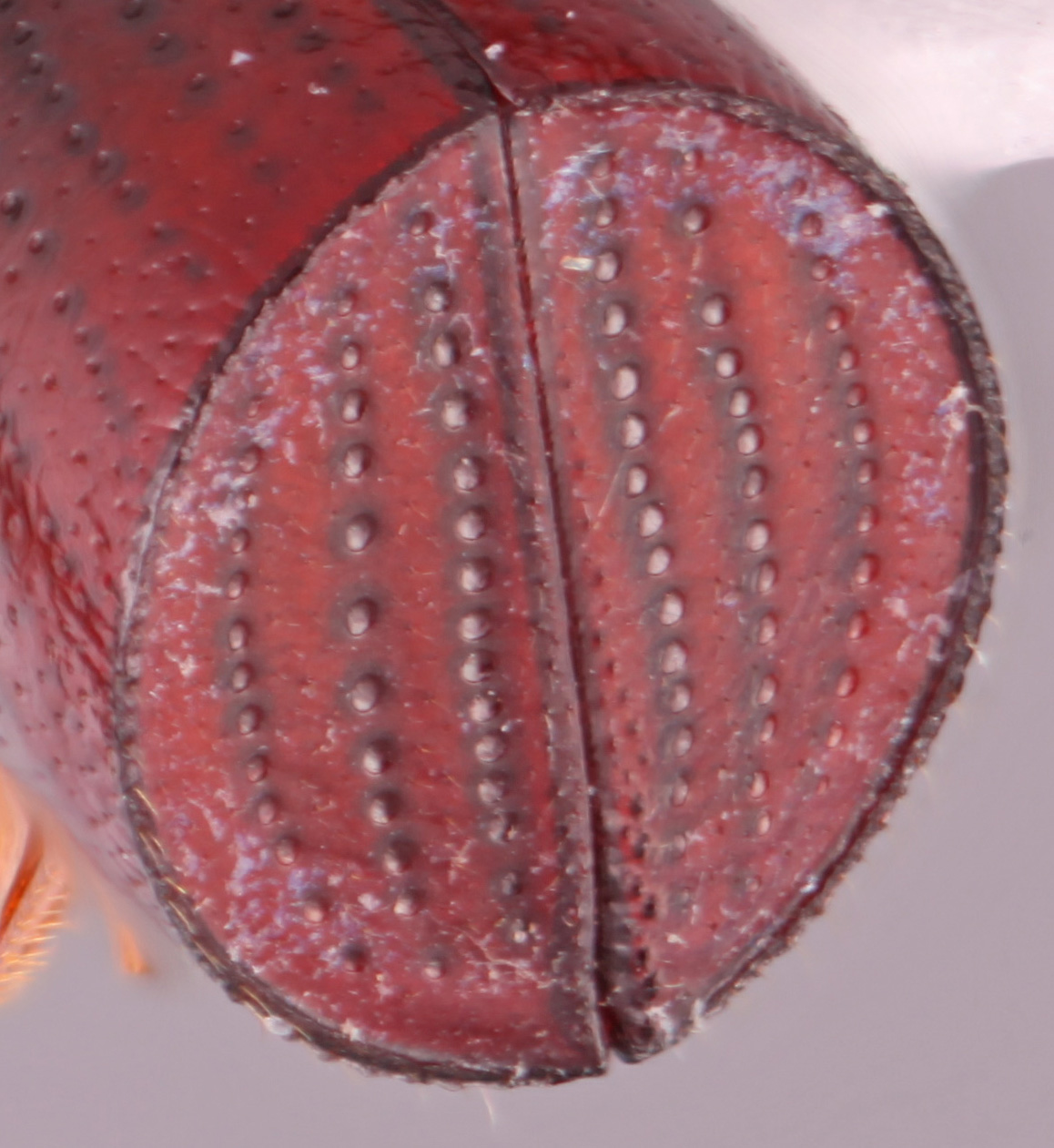 ; pronotalpronotal:
; pronotalpronotal:
pertaining to the pronotum
discdisc:
the flat central upper surface of any body part (e.g. pronotum and elytra) shining or shagreenedshagreened:
shining or shagreenedshagreened:
covered with a closely-set roughness, like shark skin  ; number and size of tuberclestubercle:
; number and size of tuberclestubercle:
a small knob-like or rounded protuberance of the exoskeleton on declivitaldeclivital:
on declivitaldeclivital:
pertaining to the elytral declivity
interstriae 2; and a large size range with individuals differing by up to 0.9 mm in length. This variation led to A. osumiensis being described several times. Types of each species are distinct and diagnosable. Examination of the specimens listed above in ‘new records’ as well as the holotypes showed that these species formed a continuous spectrum of variation. During our fieldwork we were able to collect and sequence specimens that fell within the concept of X. metanepotulus (Vietnam), X. hunanensis (China), X. nodulosus (China), A. peregrinus (Georgia, USA), and an additional larger morphospecies from multiple localities in Vietnam. COI sequences showed that all populations differed by no more than 7.4% supporting the hypothesis of one morphologically variable species. Typical intraspecific variation in xyleborines is below 10% (Cognato et al. 2020bCognato et al. 2020b:
Cognato AI, Sari G, Smith SM, Beaver RA, Li Y, Hulcr J, Jordal BH, Kajimura H, Lin C-S, Pham TH, Singh S, Sittichaya W. 2020b. The essential role of taxonomic expertise in the creation of DNA databases for the identification and delimitation of Southeast Asian ambrosia beetles species (Coleoptera: Curculionidae: Scolytinae: Xyleborini). Frontiers in Ecology and Evolution 8: 27. https://doi.org/10.3389/fevo.2020.00027).
The identification of this A. nodulosus from East Malaysia by Browne (1980b) and Ohno (1990) appears to be incorrect. We have therefore omitted East Malaysia from the distribution, and also omitted the associated host records. The host records reported in Smith et al. (2017) are therefore incorrect.
DNA data
Sequences available for COI and CAD.


